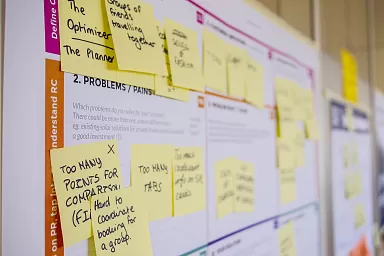As you know, your organization needs an impactful website to showcase your mission. While looking for a web design agency, you may be coming across phrases like “user research” and “UX” and you may be wondering, “What exactly is UX Design? And what are the benefits of this approach?”
UX Design stands for User Experience Design, but even the name itself is a bit misleading.
What is the Difference Between Web Design and UX Design?
When we say “web design” today, most people are referring to the visual design of a website. The difference between web design and UX Design is like trying to explain the difference between a drop of water and a puddle: web design is just a small part of what goes into a user’s experience.
Though some of UX Design is visual, most of a good UX process is focused on research, data, testing, and analysis—which is why I insist the name UX “Design” is misleading, and a little dehumanizing. I prefer the term “people-centered design”.
People-centered design is focused on research. It's an entire methodology that uncovers the needs of your audience, which in turn will help them feel more connected to your organization.
Some of the processes that a UX Designer goes through are creating:
- Personas: fictional characters based upon the research of real people. These help designers identify and connect with who the site is being built for.
- User flows: ideal workflows for how website visitors will complete a task or navigate a site.
- Wireframes: very basic designs using lines and shapes, which focuses on how content relates to one another, as opposed to how things look.
- Prototypes: a basic test version of the website or app to test design predictions.
- And much, much more depending on the project!
The Benefits of UX Design
Simply put, the benefit of investing in a good user experience for your website visitors is crucial.
People that have a good experience on your site will keep coming back, support your cause, and tell their friends about your site. On the contrary, if your website is confusing or difficult to navigate, your visitors will close the browser and move on.
On a more elemental level, providing a good user experience is simply part of being a good human being. Your website is going to make visitors feel something, and it’s important for them to have a positive experience. How do you want your supporters to feel while they’re on your site, and after they leave?
Your website is a wonderful opportunity to inspire an emotional response in potential donors—take advantage of it!
Invest in the User’s Experience: Human-Centered Design is Here to Stay
Technology will continue to evolve, and specific processes that designers and developers will ebb and flow. But—the consideration of who uses digital experiences and how they are served will always be important.
As you consider your next website project, I implore you to hire a UX expert to talk to the people who will use your site. Hire a design agency with a strong background in User Experience Design and invest in the research phase. It will help your organization have a web presence that will connect to the people you want to reach, which in turn will build more trust. By providing your supporters with a website that’s practical as well as beautiful, you will do your part to help your organization thrive in the long-term.
Here at Lucid Fox, we have several years of UX Design and People-Centered Design under our belts. We take the holistic approach to website design, from user research, to design, to development. Contact us so we can get the conversation started!

